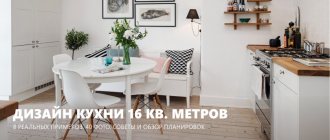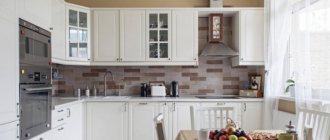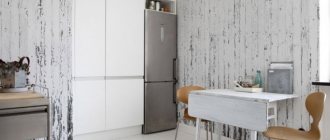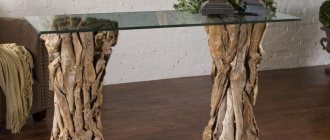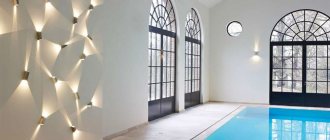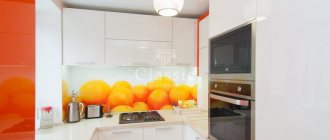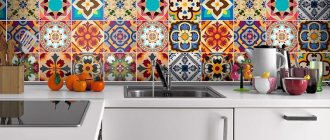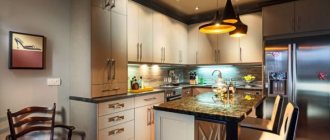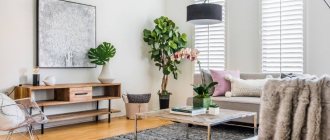In the design of a room, a kitchen apron can be a harmonious addition or a bright accent. An impressive, colorful wall finish is suitable for a kitchen decorated in 2-3 colors. An original and modern move would be to combine these two approaches.
One way or another, a kitchen apron should be pleasing to the eye, match the overall style of the kitchen, perhaps be extraordinary and have the following useful properties:
|
|
But there is no material that would 100% meet these obvious kitchen requirements. So when designing a kitchen apron, you need to find the optimal balance of important criteria. Examples are in the photo below.
However, you can use proven tricks. For example, dirt on a colored surface is not as visible as on a plain surface. And the use of various imitations of wood, stone, leather, and metal will help to beat the situation favorably and reduce costs. It is for these reasons that kitchen aprons are often made from ceramic tiles.
What finishing options are there?
Let's look at the most common options for finishing an apron in the kitchen and study the strengths and weaknesses of each type.
Ceramic tile
It is a popular and traditional solution for decorating an apron.
| pros | Minuses |
| Inexpensive, waterproof and fireproof finish that is easy to clean and has a long service life. | The seams between the tiles become dirty and absorb moisture. Therefore, the grout may need to be updated. |
| It goes well with other cladding and can be used to decorate the entire wall plane. | Laying tiles requires certain skills or the help of a specialist. |
| Ceramics imitate different textures in the form of wood, leather, marble or granite. |
Mirror tiles
If you have a small kitchen space, the choice often falls on mirror tiles. This simple technique allows you to visually create the illusion of a larger space, as if it is expanding.
But taking care of such an interior is much more difficult: any imprint, any drop of water or grease is easily applied and must be constantly washed.
Advantages and disadvantages
- Thanks to the property of reflection, mirror tiles expand the boundaries of the room, making it more spacious and bright.
- It is very difficult to care for such tiles. The tile is very easily soiled and any drop of water or grease is easily applied. This is why it needs to be washed constantly.
- There is one more drawback to mirror tiles. Anyone who prefers to install rails and hang various jars and bottles on them should refuse such tiles, since all these double kitchen utensils will significantly burden the space. And the effect of visual volume simply cannot be achieved.
Which size is better to choose?
The size depends on the dimensions of the kitchen. Basically, the work area is designed along the entire length of the kitchen unit. They also allow partial finishing of the apron only on problem areas near the sink or stove.
The photo shows a mosaic apron for a corner kitchen.
The standard height of the apron is about 50 or 60 centimeters. Individual parameters will depend on the height of the household and on how to arrange the upper cabinets, furniture, etc.
The right solution would be to finish the entire wall. It is also possible for the apron to extend slightly under the upper and lower cabinets of the kitchen unit.
The photo shows a U-shaped kitchen with an apron made of small tiles in the shape of a honeycomb.
Kitchen apron: what is it and what is it for?
The backsplash is the part of the wall that borders the countertop below and the kitchen cabinets above. Its main function is to protect the wall from splashes of water when washing dishes, greasy steam and high temperatures. It also reduces the number of kitchen design elements. Only a small part of the wall can be covered with cladding.
Fully protective finishing is generally not a cheap option. If there are no cabinets and shelves, you can decorate up to a height of 1-1.5 meters or up to the baseboard. It all depends on the style and room. When decorating, you can also consider adjacent walls.
How to choose the right color?
Dark colors are considered the most impractical options for the kitchen, since dirt is most visible. For a kitchen in neutral colors, it is better to opt for a bright apron or covering with colorful patterns.
The photo shows a backsplash with matte orange tiles in the kitchen interior.
A kitchen space in a romantic classic or Provençal style will be perfectly complemented by a light finish that will blend with the furniture and create a delicate and sophisticated atmosphere in the room. Natural beige, gray or light brown colors look beautiful.
To create an original apron in the kitchen, choose a rich pink or red design that fills the room with warmth and comfort. A blue, light blue or turquoise coating will significantly refresh the space, green and emerald cladding will create a calm atmosphere, and yellow and orange materials will bring a sunny mood to the room.
The photo shows a bright kitchen with a blue apron.
Glass apron
The glass apron burst into the interior and took a leading position. With its help, a room for preparing and eating food can turn into a designer masterpiece, even if a professional was not even there, and all the decorative elements were invented and discussed at a family council of people far from architectural innovations.
Someone can twirl their finger at their temple and say with disdain that glass is a fragile material and glass aprons are an impractical and short-lived design. But this is far from the case.
Today's technologies make it possible to endow glass with such properties that it can easily outperform mosaic or ceramic coatings. Moreover, the originality of the design, which distinguishes a kitchen splashback made of glass from any other, will make all guests green with envy and gasp, because you can choose almost any design or image.
The main thing is that they meet certain quality requirements. If you want to look at nature every day, choose flower arrangements and landscapes; if you need a working mood - geometric patterns; and if you want something tasty, then definitely fruits or sweets.
Advantages of a glass apron
- Skinali are made from durable six-millimeter sheet glass that has undergone special tempering.
- This apron does not require lengthy installation; the entire process takes only a few hours.
- It also does not require specific care: just wipe it with a sponge soaked in soapy water once a week.
- The durability and practicality of the skinali are optimally combined with its price.
- Photo printing applied to tempered glass does not fade over time, all colors continue to remain bright and saturated.
- A drawing can create any style or fit organically into an existing one.
The only drawback
- Requires more frequent maintenance as dirt on the glass is more noticeable.
Requirements for apron material
When choosing modules in the catalog of kitchen aprons, you need to pay attention to the characteristics of the selected material. The basis for creating a protective coating on the hob must meet a number of requirements:
The area of the apron, even in large kitchens, rarely exceeds 2 square meters. This way you can buy expensive, cool tiles and give your backsplash a really classy look. It’s stupid to miss this opportunity: choosing more expensive facades or countertops will cost a lot of money, but it’s quite possible to spend money on 2 meters of apron.
Tiles with imitation wood, concrete and marble look beautiful, but only with imitation and texture, and not just with a pattern.
White pork is also still in vogue and is likely here to stay. It looks too elegant in both classic and modern styles. There is no risk of looking bad - white pork is the most common and proven option.
- Strength of the material. Robust design makes the material resistant to mechanical deformation.
- Moisture resistant. The presence of an apron implies frequent cleaning of the work area, which means the upholstery does not have to be afraid of moisture.
- Resistant to high temperatures. Heat from the stove can damage some of the materials used to make backsplashes.
In addition, they pay attention to the appearance, presence of decorations and environmental indicators. The production technology must not use toxic or flammable paints and varnishes.
Technical features when choosing an apron
When choosing an apron, the size of the room is of great importance. The larger the kitchen, the less equipment there will be on the countertop, and on the apron you can choose any ornaments and small motifs. If the area is small, be prepared for the entire table to be filled, and the apron itself to be covered with railings and objects on it. As a result, he will have minimal or no designs.
Apron size range
The height of the apron varies from 50 to 65 cm; determine this parameter yourself, starting with what will be most convenient. Everyone's height is different, and height preferences also vary. If the hood is domed and not built-in, the trim must be extended by another 20-30 cm.
This is an important point if you want to order tempered glass, which will cost more. Or, if you prefer, cover the piece with another material before pulling it out and attaching it nicely to the glass.
The apron must run along the entire perimeter of the kitchen unit, and not just behind the hob and sink. First of all, it's cuter. And secondly, in these places there is always a danger of getting dirty or dirty with splashes of grease. And if there is no material that is easy to clean, all the beauty of the kitchen will fade in a year at best. If the sink is in a corner, extend the apron to the adjacent wall; this area is always the dirtiest.
Selection rules
When deciding which apron to choose, some details are taken into account:
- It should be in harmony with the overall interior, not be faded or unspectacular.
- When choosing a shade, preference is given to moderate tones. Bright things quickly tire your eyes.
- To make the shade brighter, use glossy finishes. The matte finish looks pale.
- A large print in a large room may get lost or seem inconspicuous; in a small room it may be too voluminous.
- To visually expand the space, draw a horizontal line along the perimeter of the wall.
- A glass or mirror kitchen apron will make the room visually larger. But it gets dirty quickly and requires special care.
- When finishing with tiles, you should choose a square-shaped material (the size can be any). Looks more aesthetically pleasing.
- Tiles should be purchased at a premium. This is due to the fact that it is quite fragile; if handled carelessly, cracks and chips may appear on it. Moreover, products from different batches may differ in shade.
- Smooth surfaces are easier to maintain, as dirt accumulates even on the smallest imperfections.
Common mistakes
Everyone makes mistakes. But it’s better to learn from the mistakes of others - and to warn your own in time. We talk about some of the pitfalls that accompany the design of the apron area.
Dark tones combined with grainy texture
It looks incredibly impressive, bold and always relevant. But here’s the problem: any stains are clearly visible on such a surface, and grease and soot literally eat into the top layer of the tile. Get ready to scrub them endlessly - or immediately look towards other shades.
Snow-white seams
Many owners, when laying ceramic tiles on a backsplash, want to highlight the contrast and purchase an ultra-white fugue for grouting. Of course, it immediately makes a pleasant impression and favorably emphasizes all the advantages of the chosen tile. However, over time, even waterproof grout loses its color and the seams acquire an unattractive gray tint. Therefore, it is optimal to immediately make a choice in favor of options that are not clearly contrasting.
Poor quality installation of the protective screen.
It can lead to very sad consequences when condensation from violent boiling gets onto the back side of the glass apron. As a result, the surface will become foggy instead of transparent, and if insects also crawl there, then you will have to forget about any aesthetics altogether.
Lay out the apron before installing the headset
It would seem convenient to first cover the wall with material, and then calmly hang the cabinets on top. However, this “seemingly” in practice turns out to be the fact that the furniture can rest against the tiles. If the set was made to order, this is fraught with a new fit. Therefore, the ideal algorithm is as follows: install the set - lay out the apron. And everything will be wonderful!
Peculiarities
We are not talking about a housewife's overalls in the kitchen, even if the purpose is almost the same.
An apron is a covering over the work area that protects walls and furniture from steam, high temperatures, drops of grease and food. To adequately cope with this task, for its construction it is necessary to choose a material with good characteristics that does not deform over time and can also be maintained. Although some designers choose to use trim throughout the entire wall, more often the backsplash stands out from the overall composition and serves as a striking detail using color, texture or pattern. You can buy the same finish as the countertop to harmonize the space.
Dark surfaces are considered less practical. But if the backsplash is a rich color, the rest of the room should be "muted." Horizontal stripes will help visually stretch the room, and mirror finish will add volume. Colorists recommend using warm shades, as food looks more appetizing against the background.
But these recommendations are very conditional; you need to go beyond your design skills and tastes, since the range of materials is quite wide.
Background or accent in the kitchen
There are a great variety of design styles. Of course, the finishing materials must correspond to the concept: you cannot use skins for loft-style decor or glossy acrylic panels for decorating a classic interior. However, in such a small room as a kitchen, it is necessary to take into account many other factors, because replacing the finish is a very troublesome task.
For example, what exact role will the finishing of the work area play - a background or a stylistic or color accent.
Background
In this case, the material should be a similar color to its surroundings or a matching shade. Its “invisibility” will be further enhanced by the use of the same materials, for example, ceramics or MDF panels. There are two possible solutions here.
- The apron can be one piece with the worktop. In this case, the material must match. If the countertop is decorated with MDF panels, they should also be used to decorate the work area. Acrylic looks great, imitating stone on the countertop and on the wall - such a kitchen is shown in the photo below.
It is also possible to line it with natural stone or steel - all such combinations will look harmonious, and the work area will seem more spacious. The nature of the finish is also taken into account: replacing stone is very difficult, while steel or MDF panels are easily removed.
- Another option is a combination with wall decoration. The use of the same materials is not required here, but a match or combination of colors is necessary. So, in a classic interior, white or light plaster and tiles of the same color are combined. It is also possible to use a pattern: wallpaper with a floral pattern and a combination of single-color patterned tiles with a similar floral pattern.
The design of the dining table and dining area may differ noticeably. A dark wooden dining table and ceramic finish on the countertop and backsplash are a perfectly acceptable option. In the next photo you can see this combination.
Accent
This solution is more typical of modern and rustic styles. In this case, a different material and different colors are used for finishing. You can choose single-color, bright-colored panels like in a high-tech or modern kitchen; red clinker or other finishing that imitates brick, which is typical of the English and Dutch style.
And the most universal option of this kind is skinned with photo printing. Moreover, the image is selected from bright, matching or contrasting colors used in the decoration of the room. But, it’s true, replacing an image is quite difficult, which sometimes forces you to choose a different solution.
The photo shows a night panorama of the city in combination with a dark MDF tabletop.
Best materials
If there is a question that inevitably causes headaches when posed, it is this: what material is best to make an apron from? There are many of them - and each has its own obvious advantages and no less obvious disadvantages.
Tile
The first thing that comes to mind - and this is quite fair. Still, ceramic tiles are not afraid of water, fire, or alkali, are easy to clean and are almost eternal.
Probably, even in ten years, the boar tile will not lose its relevance. Available in sizes 10x30, 10x20, 8.5x10, etc. Such collections can be found in the catalog of any manufacturer. The differences are only in color variations.
When laying ceramics on a backsplash, seams inevitably remain. They should be rubbed down with a waterproof fugue: it retains the color better and does not fall out. When choosing a grout color, you have two options:
- make seams to match the tiles;
- follow the contrast method.
There are rectified tiles on sale - they are cut along the edge at an angle of 90 degrees and are joined with a minimum seam of 1 mm. This creates a cool solid surface effect.
Patchwork is another way to beautifully highlight this area, making it the main detail of the interior. The pattern on such a tile is not solid, but is a canvas woven from shreds with different patterns. Such elements are ideal for Mediterranean design, as well as for kitchens decorated in Provence or country style. You can choose collections where the tiles have a larger format: they are much easier to lay, and there will be fewer seams.
But for high-tech, embossed surfaces that are stingy with emotions are always relevant. However, when used correctly and with skillfully adjusted lighting, they demonstrate considerable decorative potential. But remember: with matte surfaces you will have to spend a little more time cleaning.
Designer tips
Irina
Irina Polyakova is the founder of an interior studio, architect and interior designer. The main area of work is kitchen design
The latest fashion is to lay ceramic floor tiles, stylized as wood, on the backsplash. There are pitfalls here: if the surface has an overly active topography, it will be very difficult to wash it off from dirt.
Expert opinion
Dmitriy
Sales consultant in a ceramic tile store
The problem of seams is easily solved by choosing large-format porcelain tiles with a polished or matte surface. We are talking about the size 60x120, which is literally created for modern aprons: minimal trimming, a beautiful and clear monolith, excellent compatibility with any type of tabletop. Such porcelain tiles are universal and are also used as flooring, but there are also exclusively facing collections with a thickness of 6-7 mm, where the weight of each tile does not exceed 5-6 kg.
Glass skins
Let’s clarify right away: high-strength tempered glass is used to decorate the apron. The technology is simple: a transparent screen is cut out based on the measurements taken and covers any initial wall finish. For example, photo wallpaper or vinyl stickers, as in the images below.
Such glass does not crumble into fragments, but into small and not at all sharp pieces, so the risk of injury is reduced to zero. Pros:
- durability;
- immunity to water and fire;
- easy care;
- solid decorative potential.
There are also options for skinning with photo printing. The higher its quality, the longer the design will retain its freshness and color. True, the price for such work is steep - and this is the main drawback of tempered glass as a material.
MDF panels and postforming
A great way to inexpensively and aesthetically decorate an apron. Especially suitable for those who are partial to the texture of wood - and want to fit it into the format of their kitchen. Fortunately, there are options on the market for a variety of breeds - you can satisfy any “wants”, and the convenient format fits well into the allotted height of 60 cm - there is less trimming and fuss with fitting.
Those who use a gas stove should look for other design methods: the material is afraid of high temperatures. Of course, you can always protect it with a tempered glass screen, but this is an additional expense - and it is not always possible to design the insert organically.
A good alternative is postforming , which is based on chipboard covered with laminated paper. Such an apron will definitely withstand any temperature influences, will not fade in the sun and will not lose its appearance. Since the strength is high, the material is also used as a tabletop. The result is an interesting monolith that brings orderliness and harmony to the interior.
Be careful: the cheaper the stoves, the more likely they are to contain resinous substances that are unacceptable in the area where food is prepared. Therefore, be sure to check the composition of the material with sellers: your health and safety come first.
Metal
If your kitchen is decorated in a strictly modern style, it makes sense to pay attention to stainless steel as a material for decorating the apron:
- reference wear resistance;
- does not scratch;
- is not afraid of fat, water, or fire;
- gives a beautiful mirror effect;
- goes well with the chrome inserts of the kitchen set.
It seems to have been created specifically for linear high-tech interiors, radiating cold calm and calm, restrained beauty. It is inexpensive and can be easily mounted on the wall, even by those who are only comfortable with a hammer and drill.
Metal does have one drawback - maintenance. Here housewives need to come to terms with the fact that traces of fat, fingers and other cooking artifacts will always be visible on the steel surface.
Mirror
On one side of the scale there is a magnificent reflection effect, due to which even the smallest kitchen is completely transformed and acquires a nice volume.
On the other hand, there are the difficulties of cleaning, because grease and water are clearly visible on the mirror surface. Are you ready for this?
This is how you can describe the advantages and disadvantages of a mirror apron.
Designer tips
Irina
Irina Polyakova is the founder of an interior studio, architect and interior designer. The main area of work is kitchen design
Of course, an infinitely nice option that makes a dark and uncomfortable room spacious and bright. It’s also cute because it easily fits into classic and modern. Just be careful with the shelves and kitchen utensils on it: such an apron reflects not only your beautiful face, but also numerous knives, forks, spatulas and other items from the housewife’s arsenal.
If you wish, you can choose a golden-colored mirror tile and play with the color of the fittings in your kitchen in this simple way.
Mosaic
One of the most impressive ways to decorate an apron. It looks bright, fresh, rich and stylish. May be:
- glass;
- ceramic;
- from natural stone;
- smalts.
Or from different components on one sheet, due to which it shimmers beautifully when illuminated and is equally successfully implemented into any design concept.
For example, a mosaic decorated in a metallic color fits perfectly into laconic and linear modern interiors. It is in them that it becomes the main accent, which attracts attention and makes the environment unique.
Individual pixels of a mosaic canvas can give an interesting mirror effect. In combination with beautiful lighting, it often looks simply stunning even in a relatively modest interior.
Smalt mosaic consists of a large number of glass cubes and plates connected to each other on a grid of any size. One sheet can have several shapes and a dozen colors at once, so such bright and rich elements will certainly appeal to fans of the colorful Mediterranean style.
By connecting sheets together on the apron space, you can achieve a smooth transition from one color to another. This gives rise to amazing harmony and charges the space with healthy energy.
Small pixel sheets contain countless numbers of equal sized cubes. Due to the mesh base, you can cut fragments to the desired height and length without any loss to the aesthetic concept. True, the boundaries between the pixels require methodical erasing: an epoxy fugue is suitable.
A reasonable question arises: if mosaic looks so amazing in the kitchen, why is it still not so often seen in modern interiors? The answer is simple: it is an expensive pleasure. In addition to the high price of the material itself, the costs will also need to include an increased fee for the installer for installation.
A large number of stitches makes care difficult and often even exhausting. However, there is always a way out.
Expert opinion
Dmitriy
Sales consultant at a ceramic tile showroom
If the mere thought of grouting mosaic joints makes you reach for the medicine cabinet for valerian, pay attention to ceramic granite imitation. Visually, it is still the same mosaic, but made using embossing technology. It is laid like a regular tile and grouted to match the color of the joints modeled on the surface. This is a good compromise for those who are delighted with mosaic compositions, but cannot afford such an expensive and capricious pleasure in everyday life.
Plastic panels
The cheapest and easiest way to solve the issue of an apron, which is suitable for those who live, for example, in a rented apartment. Or he simply does budget repairs.
PVC panels are attached to the wall using an aluminum profile and a small amount of glue. At the same time, it does not need to be prepared: it will be fixed even with visible defects and curvature. They are thin and light, so installation is simple and there is no need to call specialists for help.
One of the advantages of plastic for an apron, along with basic installation, is the wide selection of textures and colors. There really is EVERYTHING on sale - and sometimes it’s even difficult to determine that it’s PVC and not a more expensive and solid material.
Cons: plastic is not very durable, scratches easily, quickly fades in the sun. Usually its service life does not exceed 3-4 years. In addition, you cannot put it in the kitchen with a gas stove: it melts at high temperatures.
Artificial and natural stone
Man's desire for harmony with nature motivates him to surround himself with natural textures. Therefore, aprons made of artificial and natural stone are always relevant - and will remain so, even despite the huge amount of innovative materials generated by modern technologies.
The combination of an apron and a countertop made of the same stone is a completely logical design solution. At the same time, it is important not to overdo it with the amount of dark in the space: if you see that too much is brewing, restore the balance with light facades and friendly flooring.
Granite is always popular. Natural is quite expensive, but artificial - in the form of tiles 1.5-2 cm thick - will cost much less. Very dense and durable, not afraid of water, fire, or dirt. In general, a material that has practically no weak points.
Marble is more suitable for classic interiors that are meticulous to the smallest detail, where solidity, noble appearance and even some pomp are held in high esteem. Only in the good sense of the word.
Slate and brick also fit perfectly into any interior design, imbuing the space with natural textures. If we are talking about artificial stone, then you should choose concrete. Such boards are more durable than alternative, albeit cheaper, gypsum boards. And they can easily withstand any temperature changes, permanent exposure to water and soot.
Stone in any form is good as a facing material for an apron, but its popularity is limited by the rather high cost per square meter and complex installation. Therefore, many owners make do with its ceramic imitation: it is not so expensive, but still looks just as impressive. I mean, angrily.
Table of approximate cost of materials for decorating an apron
Nothing sobers us up from our crazy fantasies of modeling our dream interior like the prices of materials. Moreover, they are now changing at the same speed with which the leaves on the tear-off calendar disappear.
To make your search easier, we have compiled a small summary table that shows the minimum cost of an apron from each of the above groups of materials. The starting point was a standard area of 2.5 meters long and 60 centimeters high. Prices are current at the time of writing.
| Material | How much will an apron cost (RUB) |
| Ceramic tile | 1600 |
| Skinali (glass) | 3500 |
| MDF | 1400 |
| Postmorphing | 2600 |
| PVC panels | 1300 |
| Mirror tiles | 1900 |
| Glass mosaic | 7500 |
| A natural stone | 4500 |
| Artificial stone (concrete) | 2300 |
